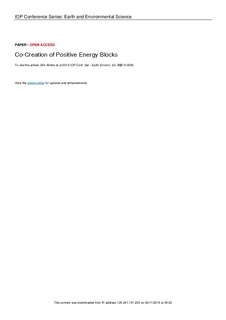| dc.contributor.author | Ahlers, Dirk | |
| dc.contributor.author | Driscoll, Patrick Arthur | |
| dc.contributor.author | Wibe, Håvard | |
| dc.contributor.author | Wyckmans, Annemie | |
| dc.date.accessioned | 2019-11-04T09:24:47Z | |
| dc.date.available | 2019-11-04T09:24:47Z | |
| dc.date.created | 2019-11-03T13:38:13Z | |
| dc.date.issued | 2019 | |
| dc.identifier.citation | IOP Conference Series: Earth and Environmental Science (EES). 2019, 352 . | nb_NO |
| dc.identifier.issn | 1755-1307 | |
| dc.identifier.uri | http://hdl.handle.net/11250/2626305 | |
| dc.description.abstract | A main challenge in building carbon-neutral built environments is the ability to scale and replicate solutions. We examine how to develop low-carbon neighbourhoods and districts, while aiming at climate-friendly and sustainable livable urban environments. We take a view that not only scales up individual building solutions, but embraces the added complexities arising from the scale change and utilizes them for a novel approach. It includes a strong focus on co-creation and open innovation to develop sustainable solutions.
In this contribution, we present the approach of the +CityxChange project in implementing Positive Energy Blocks (PEB) through a European H2020 project from the topic of Smart Cities and Communities. A PEB comprises several connected buildings that have a averaged yearly positive energy balance between them. This definition excludes embodied emissions, but allows to focus on the infrastructure and systems between buildings as part of the built environment, and ways to implement and incorporate them within existing cities. The +CityxChange approach relies on co-creating Europe-wide deployment of Positive Energy Districts, with Integrated Planning and Design, Creation of a Common Energy Market, and CommunityxChange with all stakeholders of the city. | nb_NO |
| dc.language.iso | eng | nb_NO |
| dc.publisher | IOP Publishing | nb_NO |
| dc.relation.uri | https://iopscience.iop.org/article/10.1088/1755-1315/352/1/012060 | |
| dc.rights | Navngivelse 4.0 Internasjonal | * |
| dc.rights.uri | http://creativecommons.org/licenses/by/4.0/deed.no | * |
| dc.title | Co-Creation of Positive Energy Blocks | nb_NO |
| dc.type | Journal article | nb_NO |
| dc.type | Peer reviewed | nb_NO |
| dc.description.version | publishedVersion | nb_NO |
| dc.source.pagenumber | 7 | nb_NO |
| dc.source.volume | 352 | nb_NO |
| dc.source.journal | IOP Conference Series: Earth and Environmental Science (EES) | nb_NO |
| dc.identifier.doi | 10.1088/1755-1315/352/1/012060 | |
| dc.identifier.cristin | 1743551 | |
| dc.relation.project | EC/H2020/824260 | nb_NO |
| dc.description.localcode | Content from this work may be used under the terms of theCreative Commons Attribution 3.0 licence. Any further distribution of this work must maintain attribution to the author(s) and the title of the work, journal citation and DOI. Published under licence by IOP Publishing Ltd | nb_NO |
| cristin.unitcode | 194,61,50,0 | |
| cristin.unitcode | 194,61,55,0 | |
| cristin.unitname | Institutt for arkitektur og planlegging | |
| cristin.unitname | Institutt for arkitektur og teknologi | |
| cristin.ispublished | true | |
| cristin.fulltext | postprint | |
| cristin.qualitycode | 1 | |

